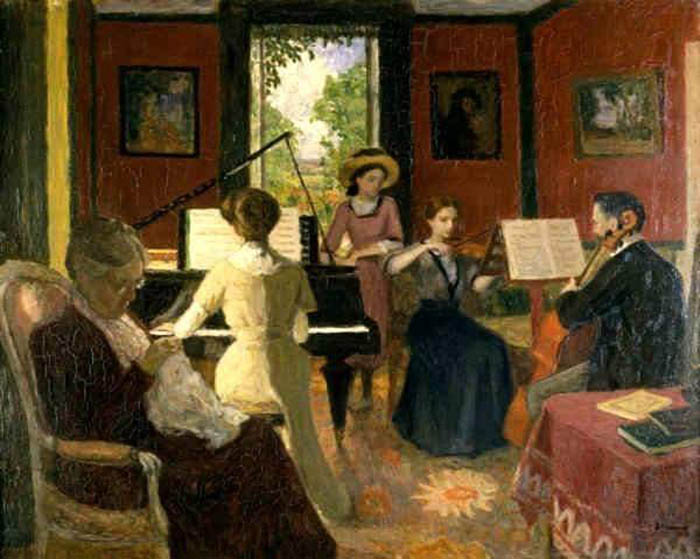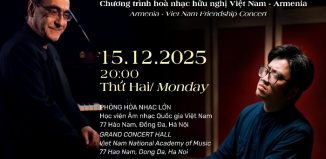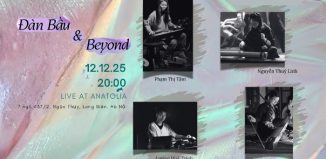HCMC – Night of French Chamber Music

Wed 23 Aug 2017, 8 pm
HCMC Opera House
From the organizer:
A night of French chamber music will be held as part of the Autumn Melodies Arts Festival 2017 in HCMC. It will feature the famous violinist Bui Cong Duy, the artists Vu Viet Chuong, Gregory Lee, Tran Huu Quoc, and talents of the International Chamber Players from the US and the Vietnam National Academy of Music (VNAM).
Program
CLAUDE DEBUSSY – Sonata for Violin and Piano in G minor, L 140 (1917)
Performers: Meritorious Artist Bui Cong Duy, Huong Trinh Nguyen
CÉSAR FRANCK – Sonata for Violin and Piano in A Major
Violin: Chuong Vu
Piano: Tran Thai Linh
Intermission
ERNEST CHAUSSON – Concerto for Piano, Violin and String Quartet in D major, Op. 21
Performers: Anastasia Markina, Gregory Lee, Tran Huu Quoc, Linh Hoang Ngo, Yi-Wen Chao, Eugene Osadchy
About the compositions
CÉSAR FRANCK – Sonata for Violin and Piano in A Major
Directly inspired by the marriage of Belgian new French music violinist Eugène Ysaÿe and Louise Bourdeau in 1886, the 64-year-old César Franck composed the work as a wedding present, which was performed “con amore” by the violinist himself and earned greater reputation to the composer’s modest public recognition in his final years.
The beginning movement was originally intended as a slow tempo, but Franck was persuaded by Ysaÿe to turn it into Allegretto, split into two themes, one for violin and one for piano that later recontextualize in following movements, a technique learned from F. Liszt. The second is a dramatic scherzo in D minor, starting as a piano toccata followed by a violin theme, either pensive or lyrical before ending in D major. The third movement, an improvisatory Recitativo-Fantasia with Wagner’s influence, is a free form reminding the previous two movements, with a dramatic violin theme. The finale, however, demonstrates a contrast, full of joy and sweetness.
It is one of Franck’s best known works, a perfect synthesis of the composer’s unique harmonic language with thematic cyclicism and Viennese Classical tradition favoured by Franck in his later life, and later being a benchmark for every aspiring violinist.
CLAUDE DEBUSSY – Sonata for violin and piano in G minor, L 140 (1917)
The Violin Sonata in G minor, L 140, for violin and piano was composed by Claude Debussy in 1917. It was the composer’s final composition (he died in 1918), forming the third work in what had originally been conceived as a cycle of six sonatas for various instruments (the first two being the cello sonata, L 135, and the sonata for flute, viola and harp, L 137). The work is notable for its brevity; a typical performance lasts about 13 minutes. The premiere took place on 5 May 1917, the violin part played by Gaston Poulet, with Debussy himself at the piano. It was his last public performance.
ERNEST CHAUSSON – Concerto for piano, violin and string quartet in D major, Op.21 (1889-91)
This rich, warm-sounding, melodic example of late French Romanticism practically defies categorization. Although Chausson called it a concerto (concert, in French), the best description would be “duet (or concerto) for violin and piano with string quartet accompaniment.
Stytlistically it is clear that Chausson seeks to avoid the spell that Richard Wagner (1813-1883) cast over late nineteenth century French music. He still uses the rich chromatic harmonies and the passionate melodic style that had come into French music in the 1870s and 1880s. But his textures and use of chords suggest an effort to find a non-Wagnerian sound through a deliberate archaism, his use of subconscious religious associations with church or amen ending. In addition, Chausson frequently uses special effects such as arpeggios, trills, and tremolos.
The first movement is based on a three-note motive introduced at the start by the piano. A main theme grows from it. A speedup in tempo leads to one of the several unaccompanied duets for violin and piano in the work. The second movement is in the old Baroque Sicilienne dance rhythm, with a light, restrained, and graceful mood. The third movement is a somber piece in slow tempo, featuring another section for the two main instruments without the quartet. The finale is in the bouncing triple-time gigue rhythm, but has the driving character of a toccata. Despite the rhythmic emphasis, Chausson introduces yet another rich and expressive melody, this time given to piano, as a contrast to the predominantly forward-moving melody.
Chausson dedicated the work to the famous Belgian violin virtuoso Eugène Ysaÿe, who did play the first performance, in Brussels in 1892, as the soloist, with pianist Auguste Pierret.
Tickets
Ticket price: 550.000 – 400.000 – 350.000 – 200.000 – 80.000VNĐ (Student Area)
Booking and delivery:
* At HBSO Box Office: No.7 Lam Son Square, Dist. 1, HCMC (basement)
* Phone: 028 3823 7295, Ms. Ngoc: 090 360 4539
* Booking online: ticketbox.vn
Website: hbso.org.vn
Follow updates on event page.
| HCMC Opera House No. 7 Lam Son Square, D.1, HCMC |
















